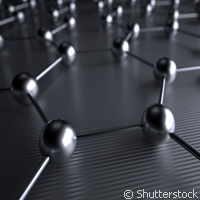New 10-year, billion-euro plan for graphene
Graphene, a new substance coming from the world of atomic scale manipulation of matter, could be the wonder material of the 21st century. Discovering just how important this material will be for information and communication technologies (ICTs) is the main focus of the Seventh Framework Programme (FP7) Coordination Action GRAPHENE-CA, funded under the 'Ideas' Theme. Graphene is the two-dimensional crystalline form of carbon: a single layer of carbon atoms arranged in hexagons, with an atom at each nexus. As free-standing objects, it was believed such two-dimensional crystals were impossible to create - or even to exist - until physicists at the University of Manchester actually produced graphene in 2004. As a crystal, two-dimensional graphene is quite dissimilar from three-dimensional materials such as silicon. Unlike other materials, the electrons in graphene move without collisions over great distances, even at room temperature. Subsequently, the ability of electrons to conduct electrical current is 10 to 100 times greater than that of semiconductors. This makes graphene a very promising candidate for future electronic applications. GRAPHENE-CA aims to explore the potential of graphene, in terms of both conventional and radically new ICT applications. By bringing together multiple disciplines and addressing a wide range of issues, from fundamental understanding of material properties to graphene production, this ambitious initiative will provide structured plans for new research needed and routes for implementation in industrially viable technologies. Nine partners are actively involved in the graphene research and networking activities: the Universities of Manchester, Lancaster and Cambridge in the United Kingdom, the Catalan Institute of Nanotechnology in Spain, Gesellschaft für Angewandte Mikro- und Optoelektronik mbH (AMO GmbH) in Germany, the European Science Foundation, the Italian National Research Council, the Nokia Corporation, and coordinator Chalmers University of Technology in Sweden. GRAPHENE-CA, which started on 1 May 2011, will pave the way for the 10-year, EUR-1,000-million Future and Emerging Technologies (FET) Flagship Initiative 'Graphene-driven revolutions in ICT and beyond' (GRAPHENE). The action plan for the Flagship Initiative will be submitted to the European Commission in 2012, aiming for GRAPHENE to be launched as one of the two active Flagships in 2013. The GRAPHENE Flagship Initiative will bring together a large, interdisciplinary European research community, including more than 130 research groups, acting as a sustainable incubator of new branches of ICT applications based on graphene, and ensuring that European industries will have a major role in this radical technology shift over the next 10 years. GRAPHENE-CA leader, Professor Jari Kinaret from Chalmers University of Technology, says: 'We are convinced that exploiting the full potential of graphene will have huge impacts on society at large, and thrilled that the European Commission shares our view and believes in our focused and open approach to moving forward.'For more information, please visit: Chalmers University of Technologyhttp://www.chalmers.se/en/Pages/default.aspxGRAPHENE Flagshiphttp://www.graphene-flagship.eu/EU Future and Emerging Technologies (FET) Flagship Initiativeshttp://cordis.europa.eu/fp7/ict/programme/fet/flagship/home_en.html
Countries
Germany, Spain, Italy, Sweden, United Kingdom



